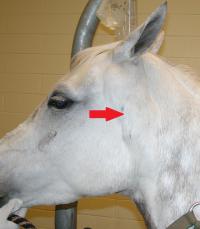Equine Melanoma: The Gray Areas
Owners of gray horses should pay attention to lumps and bumps on their horses’ skin, especially as their horses get older. They are primarily on the lookout for melanomas, skin tumors common in gray horses.
Melanoma is a cancer of melanocytes, specialized skin cells that produce pigments for skin and hair color (among other things). Melanomas appear as small, black, dome-shaped bumps. They often occur under the tail, in anal and genital regions, on lips and eyelids, and under the throatlatch. Tumor location can affect a horse’s quality of life, especially as they get larger over time. Horses can also develop internal melanomas, which are usually life-threatening.
Melanomas are generally slow-growing tumors. They are usually initially benign but can become malignant and metastasize to other locations in the body.

Genetics and the Graying Process
A supply of stem cells makes new melanocytes as hair grows and sheds. Gray horses possess one of two genetic copy number variants that supercharges this process and prematurely exhausts the stem cell supply. The hair essentially runs out of color and has no way to make more. This explains why these horses are born with pigmented coats that turn gray over time. Unfortunately, supercharging the process can predispose horses to develop malignant cells that lead to melanoma.
Speed of Graying and Melanoma Incidence
Gray is an autosomal dominant trait, meaning that a horse needs one version of the genetic variant to be gray, regardless of the variants it has for other color genes (chestnut, bay, black)*. UC Davis researchers at the Veterinary Genetics Laboratory (VGL) participated in a recent study that showed gray is caused by differences in the number of copies of the genetic variant. Some gray horses result from two copies (G2 allele) while others have a version with three copies (G3 allele) (Rubin, 2024).
Breeds such as Connemara ponies show pronounced variation in the speed of graying. Fast graying horses are white by 10 years of age, whereas slow graying horses stay dappled. Fast graying horses (those with the G3 allele) have a higher incidence of melanoma than slow graying horses (those with the G2 allele).
Research has shown that speed of graying and melanoma incidence comes down to the number of copies of the gray genetic variant. Up to six copies have been identified in fast graying individuals, with up to nine copies present locally in the melanomas themselves.
Melanomas in Non-Gray Horses

Although melanomas are observed at a higher frequency in gray horses, non-gray horses can be affected. Melanomas in solid-colored horses are more severe, often metastasizing to lymph nodes or organs, making them difficult to treat and leading to a poor prognosis. The genetic risk behind melanomas in non-gray horses is not well understood.
Melanoma Treatment
The first choice for melanoma treatment is surgical excision with wide margins. Tumor regrowth at the same site is unlikely in cases with clean surgical margins. However, surgery at one site does not reduce tumor development at other sites and it may not be an option in advanced cases. Local chemotherapy may be used for small tumors, but melanomas are generally resistant to systemic chemotherapy. Radiation therapy may be used to treat melanomas in some locations, like the throatlatch region.
Melanoma Vaccines

Melanoma vaccination strategies have been explored, but data interpretation has been challenging due to a lack of control groups and reports of wide-ranging data.
The ONCEPT™ canine melanoma vaccine, licensed for oral melanoma treatment in dogs, can be obtained for off-label use in horses by veterinary oncologists. A small study in unaffected horses demonstrated that the vaccine is safe and generates an immune response but did not test for a clinical response (Lembcke et al. 2012). A clinical trial that used the vaccine to treat 50 horses with melanomas reported tumor shrinkage in most horses (Phillips et al. 2012). More studies are needed to evaluate the effectiveness of melanoma vaccines in horses.
More Research is Needed
There is no clear consensus on the best ways to treat melanomas. Even if they are successfully removed, new melanomas develop, especially as horses age. Further research is needed to better understand tumor development and progression and how best to treat the disease.
It is important to note that although melanomas are common in gray horses, and in severe cases euthanasia may be necessary, there is no evidence that gray horses have shorter lifespans than non-gray horses.
*The VGL offers genetic testing for gray and a variety of other equine coat colors. The gray test now reports copy number and the G2 and G3 alleles when it is resolvable. The non-gray allele is reported as N. Testing requires 20-30 pulled hairs and results are available in approximately two weeks.
